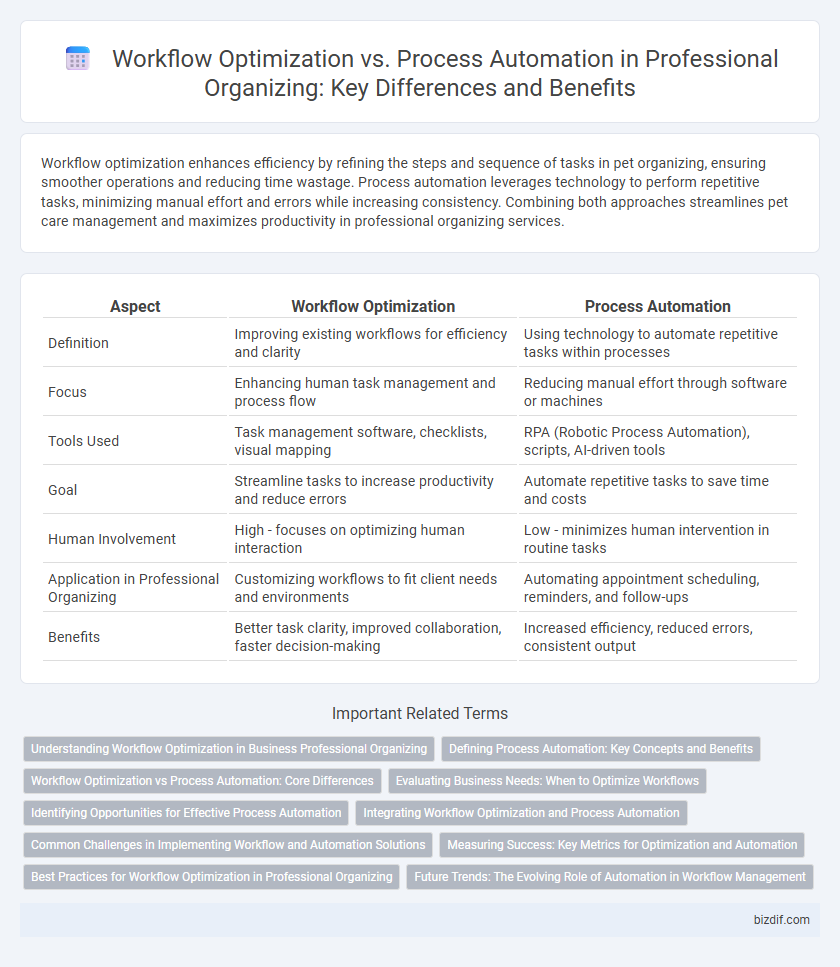Workflow optimization enhances efficiency by refining the steps and sequence of tasks in pet organizing, ensuring smoother operations and reducing time wastage. Process automation leverages technology to perform repetitive tasks, minimizing manual effort and errors while increasing consistency. Combining both approaches streamlines pet care management and maximizes productivity in professional organizing services.
Table of Comparison
| Aspect | Workflow Optimization | Process Automation |
|---|---|---|
| Definition | Improving existing workflows for efficiency and clarity | Using technology to automate repetitive tasks within processes |
| Focus | Enhancing human task management and process flow | Reducing manual effort through software or machines |
| Tools Used | Task management software, checklists, visual mapping | RPA (Robotic Process Automation), scripts, AI-driven tools |
| Goal | Streamline tasks to increase productivity and reduce errors | Automate repetitive tasks to save time and costs |
| Human Involvement | High - focuses on optimizing human interaction | Low - minimizes human intervention in routine tasks |
| Application in Professional Organizing | Customizing workflows to fit client needs and environments | Automating appointment scheduling, reminders, and follow-ups |
| Benefits | Better task clarity, improved collaboration, faster decision-making | Increased efficiency, reduced errors, consistent output |
Understanding Workflow Optimization in Business Professional Organizing
Workflow optimization in business professional organizing focuses on refining task sequences and resource allocation to enhance efficiency and reduce redundancies. It involves analyzing existing workflows to identify bottlenecks and implementing strategic adjustments that improve team collaboration and project outcomes. Unlike process automation, which relies on technology to perform repetitive tasks, workflow optimization emphasizes human-centered improvements and systemic alignment for sustainable productivity gains.
Defining Process Automation: Key Concepts and Benefits
Process automation involves using technology to execute recurring tasks or workflows automatically, minimizing human intervention while enhancing efficiency and accuracy. Key concepts include automation software, robotic process automation (RPA), and integration tools that streamline complex operations across multiple systems. Benefits encompass reduced operational costs, faster task completion, and improved consistency in professional organizing workflows.
Workflow Optimization vs Process Automation: Core Differences
Workflow optimization focuses on improving efficiency by analyzing and refining existing tasks to eliminate redundancies and enhance productivity. Process automation uses technology to execute repetitive workflows with minimal human intervention, increasing speed and consistency. The core difference lies in workflow optimization emphasizing human-driven improvements, while process automation centers on leveraging software to perform tasks automatically.
Evaluating Business Needs: When to Optimize Workflows
Evaluating business needs is crucial for determining when to prioritize workflow optimization over process automation in professional organizing. Workflow optimization enhances task efficiency by streamlining existing processes and eliminating redundancies, ideal for organizations facing inconsistent operations or resource constraints. Process automation suits businesses with repetitive, high-volume tasks, leveraging technology to reduce manual effort and increase accuracy.
Identifying Opportunities for Effective Process Automation
Identifying opportunities for effective process automation begins with analyzing repetitive tasks that consume significant time within the workflow. Professional organizing leverages data-driven insights to streamline these processes, reducing manual effort and minimizing errors. Implementing automation in targeted areas enhances overall efficiency while allowing teams to focus on higher-value activities.
Integrating Workflow Optimization and Process Automation
Integrating workflow optimization and process automation enhances efficiency by streamlining tasks and reducing manual errors in professional organizing. Workflow optimization identifies bottlenecks and redundancies, enabling tailored improvements, while automation executes repetitive actions with precision and speed. Combining these approaches drives consistent productivity gains and supports scalable organizational systems.
Common Challenges in Implementing Workflow and Automation Solutions
Common challenges in implementing workflow optimization and process automation solutions include resistance to change from employees accustomed to manual processes, the complexity of integrating new systems with legacy software, and inadequate training leading to underutilization of automation tools. Data inconsistencies and lack of standardized procedures often result in workflow bottlenecks that undermine the effectiveness of automation initiatives. Ensuring clear communication and continuous monitoring are critical to overcoming these barriers and maximizing operational efficiency.
Measuring Success: Key Metrics for Optimization and Automation
Measuring success in workflow optimization involves tracking key performance indicators such as cycle time reduction, error rate, and employee productivity to identify process efficiencies. In process automation, metrics like automation rate, process bottlenecks eliminated, and return on investment (ROI) quantify the impact of technology integration. Combining these metrics enables professional organizers to evaluate improvements in operational effectiveness and ensure sustainable process enhancements.
Best Practices for Workflow Optimization in Professional Organizing
Workflow optimization in professional organizing emphasizes streamlining task sequences and minimizing redundant steps to enhance efficiency and accuracy. Best practices include mapping existing workflows, identifying bottlenecks, and implementing standardized procedures tailored to client needs. Integrating process automation tools strategically can support repetitive tasks, but maintaining human oversight ensures flexibility and personalized service quality.
Future Trends: The Evolving Role of Automation in Workflow Management
Workflow optimization focuses on refining human tasks and improving efficiency through strategic organization, whereas process automation leverages technology to execute repetitive tasks independently. Future trends indicate a growing integration of artificial intelligence and machine learning, enabling intelligent automation that dynamically adjusts workflows for maximum productivity. This evolution in workflow management is driving smarter, more adaptive systems that reduce manual intervention and enhance decision-making accuracy.
workflow optimization vs process automation Infographic

 bizdif.com
bizdif.com